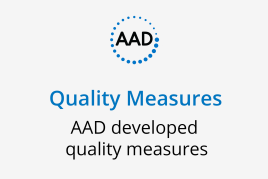Choosing wisely: Recommendations about treatments, tests, and procedures
The ABIM Foundation’s Choosing Wisely® campaign is focused on encouraging physicians and patients to talk about medical tests and procedures that may be unnecessary, and in some instances, can cause harm. To join, a medical society must provide expert guidance on five medical tests or treatments commonly used in its field.
The Academy has identified 10 evidence-based recommendations that can support conversations between patients and dermatologists about treatments, tests, and procedures that may not be needed.
Do not prescribe oral antifungal therapy for suspected nail fungus without confirmation of fungal infection
Explanation: Approximately half of nails with suspected fungus do not have a fungal infection. As other nail conditions, such as nail dystrophies, may look similar in appearance, it is important to ensure accurate diagnosis of nail disease before beginning treatment. By confirming a fungal infection, patients are not inappropriately at risk for the side effects of antifungal therapy, and nail disease is correctly treated.
Source:
1. Kreijkamp-Kaspers S, Hawke K, Guo L, Kerin G, Bell-Syer SE, Magin P, Bell-Syer SV, van Driel ML. Oral antifungal medication for toenail onychomycosis. The Cochrane Library. 2017.
2. Ameen M, Lear JT, Madan V, Mohd Mustapa MF, Richardson M. British Association of Dermatologists' guidelines for the management of onychomycosis 2014. Br J Dermatol. 2014 Nov;171:937-58.
3. Nenoff P, Reinel D, Mayser P, et al. S1 Guideline onychomycosis. J Dtsch Dermatol Ges. Jun 2023;21(6):678-692. doi:10.1111/ddg.14988.
Do not perform sentinel lymph node biopsy, or other diagnostic tests for the evaluation of early, thin melanoma because they do not improve survival
Explanation: Patients with early, thin melanoma, such as melanoma in situ, T1a melanoma, or T1b melanoma ≤ 0.5mm, have a very low risk of the cancer spreading to the lymph nodes or other parts in the body. Further, patients with early, thin melanoma have a 97% five-year survival rate which also indicates a low risk of the cancer spreading to other parts of the body. As such, the performance of sentinel lymph node biopsy is unnecessary. Additionally, baseline blood tests and radiographic studies (e.g. chest radiographs, CT scans, and PET scans) are not the most accurate tests for the detection of cancer that is spreading as they have high false-positive rates. These tests have only shown benefit when performed as indicated for suspicious signs and symptoms based on the patient’s history and physical exam.
Source:
1. Rosko AJ, Vankoevering KK, McLean SA, Johnson TM, Moyer JS. Contemporary management of early-stage melanoma: A systematic review. JAMA Facial Plast Surg. 2017;19:232-8.
2. Swetter, SM, Tsao H, Bichajkian CK, Curiel-Lewandrowski C, Elder DE, Gershenwald JE, Guild V, Grant-Kels JM, Halpern AC, Johnson JM, Sober AJ, Thompson JA, Wisco OJ, Wyat S, Hu S, Lamina T. Guidelines of care for the management of primary cutaneous melanoma. J Am Acad Dermatol. 2019;80(1):208-50
3. American Joint Committee on Cancer, AJCC Cancer Staging Manual, Eighth Edition: 2017.
4. NCCN Clinical Practice Guidelines in Oncology. Melanoma: Cutaneous Version 2.2024. https://www.nccn.org/professionals/physician_gls/pdf/cutaneous_melanoma.pdf. Published 2024. Updated 4/3/2024. Accessed 4/11/2024.
5. Garbe C, Amaral T, Peris K, et al. European consensus-based interdisciplinary guideline for melanoma. Part 1: Diagnostics: Update 2022. Eur J Cancer. Jul 2022;170:236-255. doi:10.1016/j.ejca.2022.03.008.
6. Kim D, Chu S, Khan AU, et al. Risk factors and patterns of recurrence after sentinel lymph node biopsy for thin melanoma. Arch Dermatol Res. Apr 2022;314(3):285-292. doi:10.1007/s00403-021-02229-8.
Do not treat uncomplicated, keratinocyte carcinoma (BCC or SCC) less than 1 centimeter in size on the trunk and extremities with Mohs Micrographic Surgery, in otherwise healthy individuals.
Explanation: In healthy individuals, the use of Mohs Micrographic Surgery for low-risk, small (< 1cm), superficial, or non-aggressive (based on appearance under a microscope) squamous cell carcinomas and basal cell carcinomas is inappropriate for skin cancers on the trunk and extremities. In these areas of the body, the clinical benefits of this specialized surgical procedure do not exceed the potential risks. It is important to note that Mohs Micrographic Surgery may be considered for skin cancers appearing on the hands, feet, ankles, shins, nipples, or genitals, as they have been shown to have a higher risk for recurrence or require additional surgical considerations.
Source:
1. Bichakjian C, Armstrong A, Baum C, Bordeaux JS, Brown M, Busam KJ, Eisen DB, Iyengar V, Lober C, Margolis DJ, Messina J. Guidelines of care for the management of basal cell carcinoma. J Am Acad of Dermatol. 2018;78(3):540-59.
2. Alam M, Armstrong A, Baum C, Bordeaux JS, Brown M, Busam KJ, Eisen DB, Iyengar V, Lober C, Margolis DJ, Messina J. Guidelines of care for the management of cutaneous squamous cell carcinoma. J Am Acad Dermatol. 2018;78(3):560-78.
3. Connolly SM, Baker DR, Coldiron BM, Fazio MJ, Storrs PA, Vidimos AT et al. AAD/ACMS/ASDSA/ASMS 2012 appropriate use criteria for Mohs micrographic surgery: a report of the American Academy of Dermatology, American College of Mohs Surgery, American Society for Dermatologic Surgery Association, and the American Society for Mohs Surgery. J Am Acad Dermatol. 2012 67:531-50.
4. NCCN Clinical Practice Guidelines in Oncology. Basal Cell Skin Cancer. Version 3.2024. https://www.nccn.org/professionals/physician_gls/pdf/nmsc.pdf. Published 2024. Updated 3/1/2024. Accessed 4/11/2024.
5. NCCN Clinical Practice Guidelines in Oncology. Squamous Cell Skin Cancer. Version 1.2024. https://www.nccn.org/professionals/physician_gls/pdf/squamous.pdf. Published 2023. Updated 11/9/2023. Accessed 4/11/2024.
Do not routinely use oral antibiotics for treatment of atopic dermatitis
Explanation: The presence of high numbers of the Staphylococcus aureus (staph) bacteria on the skin of children and adults with atopic dermatitis (AD) is quite common. While it is widely believed that staph bacteria may play a role in causing skin inflammation, the routine use of oral antibiotic therapy to decrease the amount of bacteria on the skin has not been definitively shown to reduce the signs, symptoms (e.g. redness, itch), or severity of atopic dermatitis. In addition, if oral antibiotics are used when there is not an infection, it may lead to the development of antibiotic resistance. The use of oral antibiotics also can cause side effects, including hypersensitivity reactions (exaggerated immune responses, such as allergic reactions). Although it can be difficult to determine the presence of a skin infection in atopic dermatitis patients, oral antibiotics should only be used to treat patients with evidence of bacterial infection in conjunction with other standard and appropriate treatments for atopic dermatitis.
Source:
1. Francis NA, Ridd MJ Thomas-Jones E, Butler CC, Hood K, Shepherd V, Marwick CA, Huang C, Longo M, Wootton M, Sullivan F. Oral and topical antibiotics for clinically infected eczema in children: a pragmatic randomized controlled trial in ambulatory care. Ann Fam Med. 2017;15:124-30.
2. Sidbury R, Davis DM, Cohen DE, Cordoro KM, Berger TG, Bergman JN, et al. Guidelines of care for the management of atopic dermatitis: section 3. Management and treatment with phototherapy and systemic agents. J Am Acad Dermatol. 2014 Aug;71(2):327-49.
3. Davis DMR, Drucker AM, Alikhan A, et al. Executive summary: Guidelines of care for the management of atopic dermatitis in adults with phototherapy and systemic therapies. J Am Acad Dermatol. Feb 2024;90(2):342-345. doi:10.1016/j.jaad.2023.08.103.
Do not routinely use topical antibiotics on a surgical wound
Explanation: Any possible reduction in the rate of infection from the use of topical antibiotics on clean surgical wounds compared to the use of non-antibiotic ointment or no ointment is quite small. Risk reduction may be overshadowed by the risks of wound irritation or contact dermatitis. When topical antibiotics are used in this setting, there is a significant risk of developing contact dermatitis, a condition in which the skin becomes red, sore, or inflamed after direct contact with a substance, along with the potential for developing antibiotic resistance. Only wounds that show symptoms of infection should receive appropriate antibiotic treatment.
Source:
1. Heal CF, Banks JL, Lepper PD, Kontopantelis E, van Driel ML. Topical antibiotics for preventing surgical site infection in wounds healing by primary intention. Cochrane Database of Systemic Reviews. 2016.
2. Norman G, Dumville JC, Mohapatra DP, Owens GL, Crosbie EJ. Antibiotics and antiseptics for surgical wounds healing by secondary intention. Cochrane Database of Systematic Reviews. 2016.
3. Dixon AJ, Dixon MP, Dixon JB. Randomized clinical trial of the effect of applying ointment to surgical wounds before occlusive dressing. Br J Surg. 2006 Aug;93:937-43.
4. Smack DP, Harrington AC, Dunn C, Howard RS, Szkutnik AJ, Krivda SJ, Caldwell JB, James WD. Infection and allergy incidence in ambulatory surgery patients using white petrolatum vs bacitracin ointment. A randomized controlled trial. JAMA. 1996;276:972-7.
5. Campbell RM, Perlis CS, Fisher E, Gloster HM Jr. Gentamicin ointment versus petrolatum for management of auricular wounds. Dermatol Surg. 2005;31:664-9.
6. Sheth VM, Weitzul S. Postoperative topical antimicrobial use. Dermatitis. 2008;19:181-9.
7. Gehrig KA, Warshaw EM. Allergic contact dermatitis to topical antibiotics: Epidemiology, responsible allergens, and management. J Am Acad Dermatol. 2008;58(1):1-21.
8. Saco M, Howe N, Nathoo R, Cherpelis B. Topical antibiotic prophylaxis for prevention of surgical wound infections from dermatologic procedures: a systematic review and meta-analysis. J Dermatolog Treat. 2014 Apr 8: 1-8.
Do not use systemic (oral or injected) corticosteroids as a long-term treatment for dermatitis
Explanation: The potential complications of long-term treatment with oral or injected corticosteroids outweigh the potential benefits. Although the short-term use of systemic corticosteroids is sometimes appropriate to provide relief of severe symptoms, long-term treatment could cause serious short- and long-term adverse effects in both children and adults. In extreme cases that have failed to respond to other appropriate treatments, the benefits of systemic corticosteroids must be weighed against these potentially serious risks.
Source:
1. Yu S, Drucker AM, Lebwohl M, Silverberg JI. A systematic review of safety and efficacy of systemic corticosteroids in atopic dermatitis. J Am Acad Dermatol. DOI: https://doi.org/10.1016/j.jaad.2017.09.074.
2. Sidbury R, Davis DM, Cohen DE, Cordoro KM, Berger TG, Bergman JN et al. Guidelines of care for the management of atopic dermatitis: section 3. Management and treatment with phototherapy and systemic agents. J Am Acad Dermatol 2014;71:327-49.
3. Thyssen JP, Schuttelaar MLA, Alfonso JH, et al. Guidelines for diagnosis, prevention, and treatment of hand eczema. Contact Dermatitis. 2022;86(5):357-378. doi:10.1111/cod.14035
4. Usatine RP, Riojas M. Diagnosis and management of contact dermatitis. Am Fam Physician 2010;82:249-55.
5. Krejci-Manwaring J, McCarty MA, Camacho F, Manuel J, Hartle J, Fleischer A, Jr. et al. Topical tacrolimus 0.1% improves symptoms of hand dermatitis in patients treated with a prednisone taper. J Drugs Dermatol 2008;7:643-6.
6. Silvestre-Salvador JF, Heras Mendaza F, Hervella Garcés M, et al. Guidelines for the Diagnosis, Treatment, and Prevention of Hand Eczema. Guía para el diagnóstico, el tratamiento y la prevención del eccema de manos. Actas Dermosifiliogr. 2020;111(1):26-40. doi:10.1016/j.ad.2019.04.005.
7. Chu AWL, Wong MM, Rayner DG, et al. Systemic treatments for atopic dermatitis (eczema): Systematic review and network meta-analysis of randomized trials. J Allergy Clin Immunol. Dec 2023;152(6):1470-1492. doi:10.1016/j.jaci.2023.08.029.
8. Davis DMR, Drucker AM, Alikhan A, et al. Executive summary: Guidelines of care for the management of atopic dermatitis in adults with phototherapy and systemic therapies. J Am Acad Dermatol. Feb 2024;90(2):342-345. doi:10.1016/j.jaad.2023.08.103.
Do not use skin prick tests or blood tests such as RAST for the routine evaluation of eczema
Explanation: Skin prick tests, which are conducted with a needle, or blood tests may help identify causes of allergic reactions including hives or sneezing after exposure to dust or pollen. However, these tests are not useful for diagnosing dermatitis or eczema. For these rashes, when testing is deemed necessary, patch testing with ingredients of products that come in contact with the patient’s skin is a better test to look for suspected allergies.
Source:
1. Sidbury R, Tom WL, Bergman JN, Cooper KD, Silverman RA, Berger TG et al. Guidelines of care for the management of atopic dermatitis: Section 4. Prevention of disease flares and use of adjunctive therapies and approaches. J Am Acad Dermatol 2014;71:1218-33.
2. Boyce JA, Assa'ad A, Burks AW, Jones SM, Sampson HA, Wood RA et al. Guidelines for the diagnosis and management of food allergy in the United States: report of the NIAID-sponsored expert panel. J Allergy Clin Immunol 2010;126:S1-58.
Do not routinely use microbiologic testing in the evaluation and management of acne
Explanation: Acne has many contributing factors, of which bacteria are only one part. Microbiologic testing, used to determine the type of bacteria present in an acne lesion, is generally unnecessary because it does not affect management of typical patients with acne. Microbiologic testing should be considered only when acne has failed to respond to conventional treatments, particularly in patients who have already been treated with oral antibiotics.
Source:
1. Zaenglein AL, Pathy AL, Schlosser BJ, Alikhan A, Baldwin HE, Berson DS, et al. Guidelines of care for the management of acne vulgaris. J Am Acad Dermatol. 2016 Feb 15.
2. Reynolds RV, Yeung H, Cheng CE, et al. Guidelines of care for the management of acne vulgaris. J Am Acad Dermatol. Jan 30 2024;doi:10.1016/j.jaad.2023.12.017
Do not routinely use antibiotics for treatment of bilateral swelling and redness of the lower leg unless there is clear evidence of infection
Explanation: Research has suggested that bilateral lower leg cellulitis is very rare. Patients with swelling and redness of both legs most likely have another condition, such as dermatitis related to leg swelling, varicose veins, or contact allergies. To ensure appropriate treatment, doctors must consider the likelihood of diagnoses other than cellulitis when evaluating swelling and redness of the lower legs. Misdiagnosis of bilateral cellulitis can lead to overuse of antibiotics and subject patients to potentially unnecessary hospital stays.
Source:
1. Weng QY, Raff AB, Cohen JM, Gunasekera N, Okhovat JP, Vedak P, Joyce C, Kroshinsky D, Mostaghimi A. Costs and consequences associated with misdiagnosed lower extremity cellulitis. JAMA Dermatol 2017; 153:141-146.
2. Arakaki RY, Strazzula L, Woo E, Kroshinsky D. The impact of dermatology consultation on diagnostic accuracy and antibiotic use among patients with suspected cellulitis seen at outpatient internal medicine offices: a randomized clinical trial. JAMA Dermatol 2014;150:1056-61.
3. Hughey LC. The impact dermatologists can have on misdiagnosis of cellulitis and overuse of antibiotics: closing the gap. JAMA Dermatol 2014;150:1061-2.
4. Salmon M. Differentiating between red legs and cellulitis and reviewing treatment options. Br J Community Nurs 2015;20:474-80.
5. David CV, Chira S, Eells SJ, Ladrigan M, Papier A, Miller LG et al. Diagnostic accuracy in patients admitted to hospitals with J Am Acad Dermatol 2010;62:518-9.
6. Levell NJ, Wingfield CG, Garioch JJ. Severe lower limb cellulitis is best diagnosed by dermatologists and managed with shared care between primary and secondary care. Br J Dermatol 2011;164:1326-8.
7. Kroshinsky D, Grossman ME, Fox LP. Approach to the patient with presumed cellulitis. Semin Cutan Med Surg 2007;26:168-78.
8. Hirschmann JV, Raugi GJ. Lower limb cellulitis and its mimics: part I. Lower limb cellulitis. J Am Acad Dermatol 2012;67:163:e1-12.
9. Hirschmann JV, Raugi GJ. Lower limb cellulitis and its mimics: part II. Conditions that simulate lower limb cellulitis. J Am Acad Dermatol 2012;67:177:e1-9.
Do not routinely prescribe antibiotics for inflamed epidermal cysts
Explanation: The overwhelming majority of red and swollen epidermal cysts (ECs) are inflamed but not infected. It is important to confirm infection before treating these cysts with antibiotics. Appropriate treatments for inflamed ECs include incision and drainage or an injection of corticosteroid directly into the cyst.
Source:
1. Diven DG, Dozier SE, Meyer DJ , Smith EB. Bacteriology of inflamed and uninflamed epidermal inclusion cysts. Arch Dermatol 1998;134:49-51.
2. Stevens DL et al (Clin Infect Dis 2014; 59:147-59). Clin Infect Dis. 2015;60(9):1448. doi:10.1093/cid/civ114.
To date, 75 national organizations representing medical specialists have joined the conversations about appropriate care. With the release of these recommendations, the campaign will have covered nearly 500 tests and procedures that the specialty society partners say are overused or inappropriate, and that physicians and patients should discuss. For more information on the campaign, visit www.ChoosingWisely.org.
The Academy’s Choosing Wisely list was selected by the AAD’s Choosing Wisely workgroup, who identified areas with the greatest potential for overuse/misuse, a need for quality improvement, and the availability of strong evidence-based research to support the recommendation. The final list was reviewed and approved by the Academy’s Council on Science and Research and the Academy’s Board of Directors.
 Find a Dermatologist
Find a Dermatologist
 Member directory
Member directory
 AAD Learning Center
AAD Learning Center
 2026 AAD Annual Meeting
2026 AAD Annual Meeting
 Need coding help?
Need coding help?
 Reduce burdens
Reduce burdens
 Clinical guidelines
Clinical guidelines
 Why use AAD measures?
Why use AAD measures?
 Latest news
Latest news
 New insights
New insights
 Physician wellness
Physician wellness
 Joining or selling a practice?
Joining or selling a practice?
 Promote the specialty
Promote the specialty
 Advocacy priorities
Advocacy priorities
